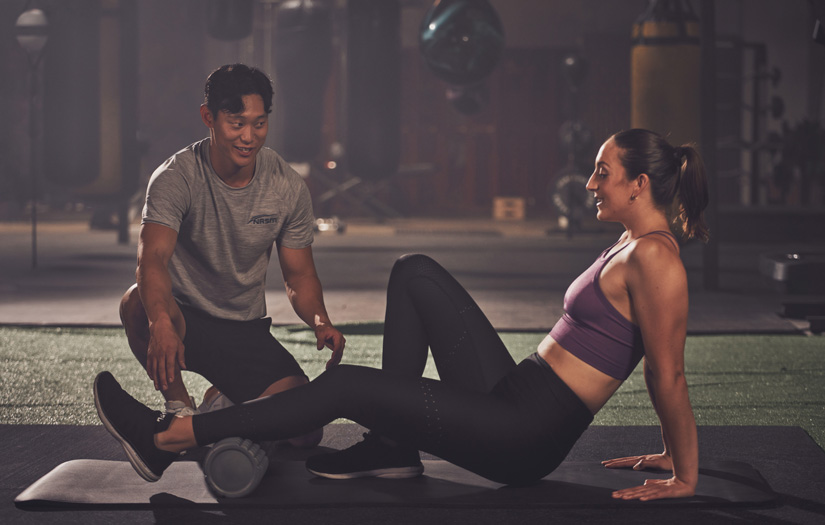Corrective exercise isn’t just about coming back from an injury, although it certainly can help. Corrective exercise could be the missing element in your client’s program that could take their performance and results from good to great.
Through movement and recovery, it helps to improve overall movement so that all of the right muscles fire at the right time and with the right intensity. Not only does this help your client get the most out of their workout, but it also reduces their risk of injury while training or competing.
Benefits of Corrective Exercise
Corrective exercise is a term used to describe the systematic process of identifying movement dysfunction, developing a plan of action, and implementing an integrated corrective strategy. To put it simply: corrective exercise is designed to help people move well!
The truth is that everyone has room for improvement when it comes to movement, largely because of the amount of time that the average person spends seated in a day. Those who compete in sports are also good candidates for corrective exercise since most sports have repetitive movement patterns that can cause some movement compensations. Think that moving better is the only benefit to performing corrective exercise? Think again! Here are some additional benefits to performing corrective exercise:
Improved movement = better results. How so? To get the most out of an exercise, the right muscle groups must fire at the right time and intensity. If there is a muscle imbalance and one muscle group is over-compensating for another, that means that the target muscle group might not be able to function at peak capacity, therefore diminishing the results. Corrective exercise can help to reverse muscle imbalances that exist so that the client gets the most bang for their buck out of their workouts.
Reduced risk of injury. In the example above, the muscles that are over-compensating during a movement are likely being overused. Additionally, when there is a muscle imbalance, it becomes increasingly difficult to maintain proper kinetic chain alignment during a movement.
Over time, this can lead to injury as form continues to break down. Correcting muscle imbalances and movement dysfunction can ensure that the right muscle is firing at the right time and that all joints are properly lined up to greatly reduce the risk of injury and enhance performance.
Reduced pain. Corrective exercise is not intended to treat pain, nor to treat musculoskeletal injury. When the client experiences pain that is a result of poor movement, then reduced pain might be a by-product of corrective exercise as their movement improves.
Physical and mental prep for training. Corrective exercise isn’t meant to be physically taxing, at least not like the workout. Even so, the act of intentionally preparing for movement by performing corrective exercise can physically and mentally prepare the client for the more challenging tasks ahead.
Common risks and injuries that occur during weightlifting and sports
Even with a comprehensive corrective protocol, there are still risks involved in participating in weightlifting and sports. According to the U.S. National Library of Medicine (2017), some of the most common injuries include sprains and strains, knee injuries, swollen muscles, shin splints, and rotator cuff injuries.
Some injuries may occur because of impact or collision, while others occur because of poor movement or overuse. And sometimes, unfortunately, accidents just happen. Whether playing a sport or training in the gym, there is always some type of risk associated with participation.
As fitness professionals, we can help our clients reduce their risk of injury that may occur because of poor movement mechanics. We also can ensure a safe training environment, and that all the exercises that we select are appropriate for the client’s skill and ability level. In addition to a well-thought-out corrective exercise program, all these elements can help to keep your client healthy and safe inside and outside of the gym (or field).
The Importance of Rest
Rest has been an increasingly hot topic in recent years, especially as work demands and overall busyness have increased. Rest is an aspect of recovery that focuses on improving daily sleep amount and quality, limiting stress, and increasing physical and psychological relaxation. Studies have shown that not enough rest can directly impact next-day performance and likelihood of injury (Halson & Juliff, 2017; Hamlin et al., 2019; Mah et al., 2011; Nedeltcheva et al., 2010; Pelka et al., 2017).
To get adequate amounts of rest, the client will need a minimum of 8 hours of sleep per night and 60 minutes of accumulated psychological relaxation per day. Psychological relaxation can include things like breathing exercises, meditation, or reading. The 60 minutes can be broken up into smaller increments throughout the day to help the client sprinkle in stress reduction techniques as they go about their day. Rest is not to be overlooked as an important part of your client’s corrective exercise protocol.
How to incorporate corrective exercise
Corrective exercise is intended to both help your client move better and to prepare them for movement. As such, corrective exercise is best positioned at the top of the workout. There are creative ways to incorporate corrective exercise without adding extra time to the session. Here are some ideas to help you plan:
Have your client foam roll and stretch on their own right before the session. This works best when you set the expectation early and hold your client accountable. If they run late, they can expect to start their session with the foam rolling and stretching. If you place a priority on it, they will also.
Include corrective exercise in the warm-up. Your client is likely already used to doing some type of warm-up with you, so this is a perfect spot to have your client perform activation exercises. For the warm-up, have your client perform a circuit of exercises that will activate the underactive muscles. These corrective exercises will serve two purposes: to help the client prepare for movement (aka: warm-up), and to help correct any faulty movement patterns that you’re working on.
Include corrective exercise in the workout. For the workout, select exercises that will help the client practice healthy movement patterns and continue to strengthen the underactive muscle groups. Avoid exercises that may exacerbate any movement compensations that they may have. For example, if your client cannot lift their arms all the way up, it might be best to avoid overhead presses until they can safely do so.
Summary
The goal of every trainer is to help their client reach their goals safely and efficiently, while minimizing the risk of injury. Corrective exercise is a great tool to use to achieve this goal. By helping your clients move well, you are helping them perform better and prevent unnecessary injury whether they’re inside of the gym or out on the playing field.
References:
Fahmy, R. (2022). Nasm Essentials of Corrective Exercise Training. Jones et Bartlett Learning.
Halson, S.L., & Juliff, L.E. (2017). Sleep, sport, and the brain. Progress in brain research, 234, 13-31. https://doi.org/10.1016/bs.pbr.2017.06.006
Hamlin M.J., Wilkes, D., Elliot, C. A., Lizamore, C. A., & Kathiravel, Y. (2019). Monitoring training loads and perceived stress in young elite university athletes. Frontiers in Physiology. 10, 34. https://doi.org/10.3389/fphys.2019.00034
Mah C. D., Mah, K. E., Kezirian, E. J., & Dement, W. C. (2011). The effects of sleep extension on the athletic performance of collegiate basketball players. Sleep, 34(7), 943-950. https://doi.org/10.5665
Nedeltcheva A. V., Kilkus, J. M., Imperial, J., Schoeller, D. A., & Penev, P. D. (2010). Insufficient sleep undermines dietary efforts to reduce adiposity. Annals of internal medicine. 153(7), 435-441. https://doi.org/10.7326/0003-4819-153-7-201010050-00006
Pelka M., Kolling, S., Ferrauti, A., Meyer, T. M., Pfeiffer, M., & Kellmann, M. (2017). Acute effects of psychological relaxation techniques between two physical tasks. Journal of Sports Sciences, 35(3), 216-223.
U.S. National Library of Medicine. (2017, January 2). Sports injuries. MedlinePlus. Retrieved December 12, 2022, from https://medlineplus.gov/sportsinjuries.html












